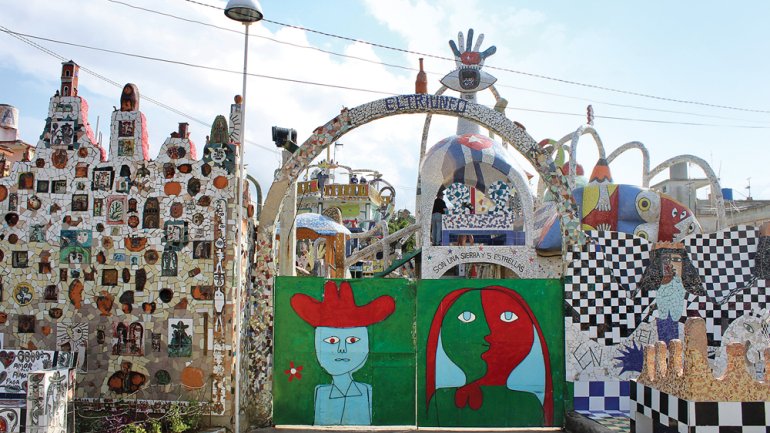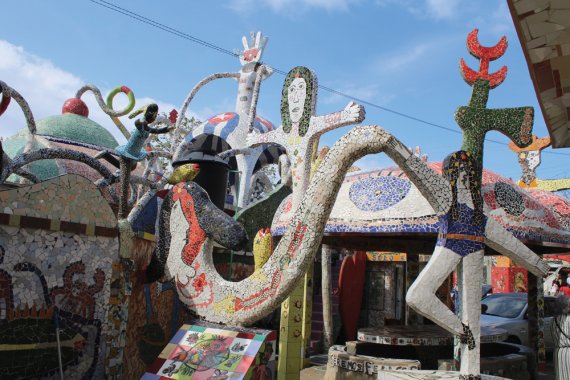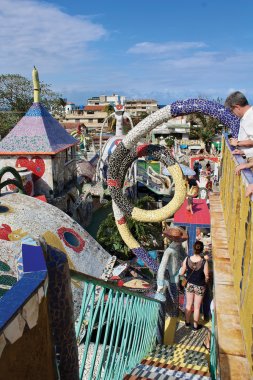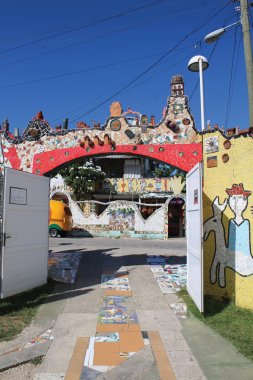Work With What You Have
Work With What You Have
As the director of an arts nonprofit, I spend hours juggling resources, writing grant proposals, and managing budgets. So it was an eye-opener to travel to Cuba last year with our first Peters Valley School of Craft tour of the country. There, though money is clearly in short supply, optimism and energy abound, and artists demonstrate rare resourcefulness and resiliency. There were lessons there for me – and maybe for all of us in the arts.
The capital city of Havana is like a movie set, a time capsule of vintage cars and vibrant, brightly painted colonial architecture. Parts of the Jaimanitas neighborhood, about 20 minutes from the center of the city, are even more eye-popping, thanks to José Fuster. He’s the driving force in the neighborhood, where many homes and small makeshift galleries are covered with intricate mosaics. Over more than four decades, Fuster has led an artistic revolution in the neighborhood, first by covering every wall of his studio compound with ceramic mosaics and inviting the public in, then by encouraging other artists to embellish the town’s buildings, and to live and sell their work there.
Today, what’s often called Fusterlandia is not only a bustling marketplace, but also a magnet for tourists. As I discovered in a two-hour conversation with Fuster in November, the drive of one man has transformed a once bleak district into a land of artistic plenty.
The 73-year-old Fuster attended art school in Havana in the early 1960s, and, seeking a place to make and sell his art, he settled in a modest house in Jaimanitas in 1975. One day, after talking with people who’d visited his studio to buy a painting, he had an insight: “What if I put my works outside my gate and made them available to the people?” he recalls. He began collecting ceramic pieces to create the mosaic gate at the entrance of his property, an homage to his longtime idol, Constantin Brâncusi. Based on Brâncusi’s Gate of the Kiss (part of a monument in the sculptor’s homeland of Romania), Fuster’s gate reads “La Alegría de Vivir” (“the joy of life”), his name for his own project, also known simply as Fusterlandia.
Soon neighbors began to ask him to create a mosaic at one gate and then another. People opened their homes for him to adorn. His colorful work started popping up all over – at bus stops and on street signs, stairways, archways, fountains, benches, and passages. Over the next 30 years, Fuster, joined by other artists, added mosaics with messages of optimism, encouragement, and gratitude, and elements of cultural and political significance.
People began to take notice, to come visit the area. Inspired by the fantastical work of Catalan architect Antoni Gaudí and Isaiah Zagar’s Magic Gardens in Philadelphia, Fuster continued to embellish his home studio, creating an homage to Brâncusi’s Table of Silence as a place for people to gather for reflection and inspiration; his table features the words “Vamos a Comer” (“Let’s eat”). A large rendition of the patron saint of Cuba, Our Lady of Charity, is adjacent to the table. Visitors can move from outdoor spaces to an interior gallery featuring Fuster’s paintings, drawings, prints, and postcards; all are for sale, to fund more mosaics at his home and throughout the neighborhood. Climb up to the rooftop overlook featuring an homage to Brâncusi’s Endless Column, and you’ll see the sweep of mosaics throughout the adjacent blocks.
Fuster’s fantastical world continues to expand. Many of his neighbors have worked on the project, and Cuban artists such as Eduardo “Choco” Roca Salazar and Zaida del Rio have decorated swaths of the district. Inspired by the setting, artists continue to flock here to set up shop. And buses still bring tourists.
When you enter Fuster’s living quarters, you’re met with an enormous mosaic heart embedded in the vaulted ceiling of his living room. It’s a potent symbol of the sheer passion and devotion that have fueled his work, in a place where resources are scarce. Fuster and the artists around him have worked with what they have at hand to build a community that draws people from around the world.
Fuster is a self-supporting artist; he has no government subsidy, no sponsor or patron. Now, as I go about my work as an arts administrator, writing grants and seeking support for our educational programs, I will remember the powerful example of a man who had little, but, working with his neighbors, built a magical cityscape. I will remember: If I’ve got drive and imagination, I have more resources than I think.







